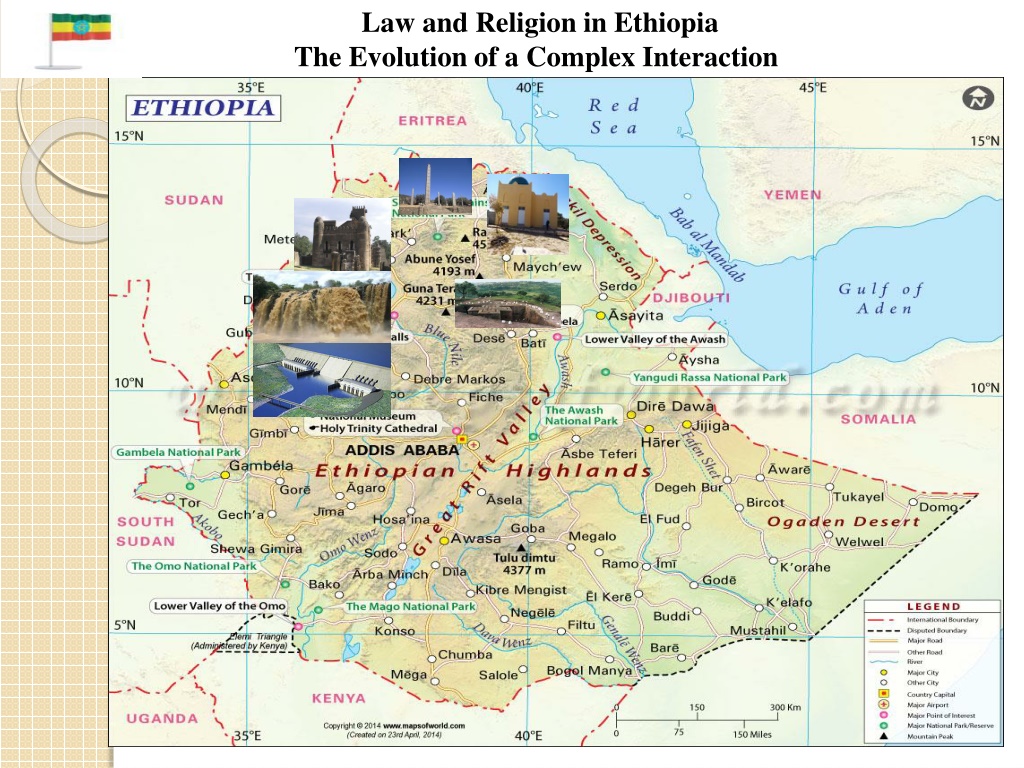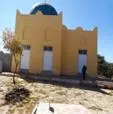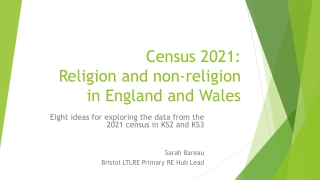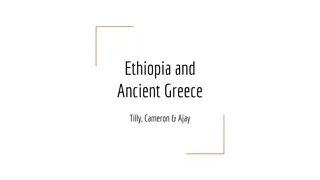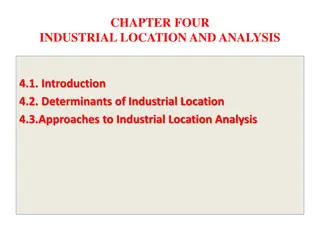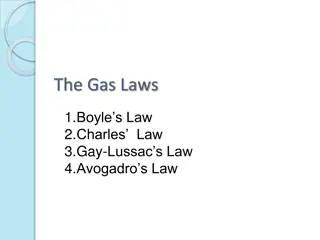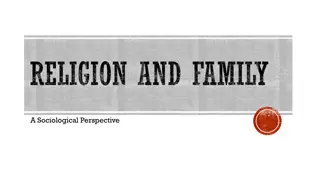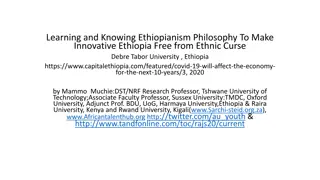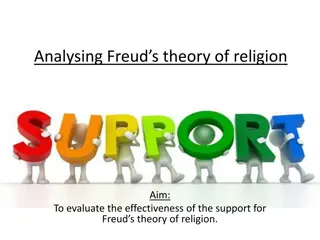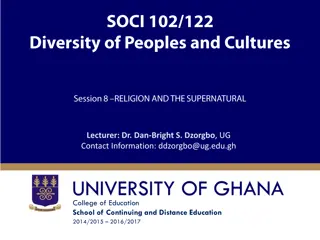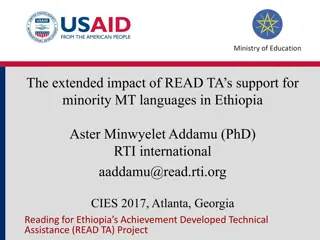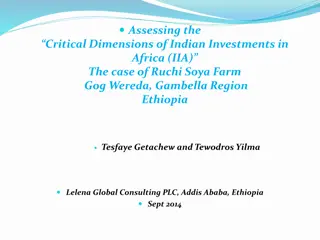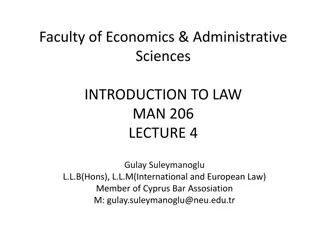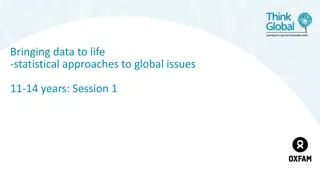Law and Religion in Ethiopia: A Historical Overview
Explore the evolution of the complex interaction between law and religion in Ethiopia, from Imperial Ethiopia to the Communist Era and the post-communist period. Discover the rich historical origins of Ethiopia, including its diverse religious landscape and unique governance structures. Delve into the fascinating historic sites and cultural heritage that define this ancient nation.
Download Presentation

Please find below an Image/Link to download the presentation.
The content on the website is provided AS IS for your information and personal use only. It may not be sold, licensed, or shared on other websites without obtaining consent from the author.If you encounter any issues during the download, it is possible that the publisher has removed the file from their server.
You are allowed to download the files provided on this website for personal or commercial use, subject to the condition that they are used lawfully. All files are the property of their respective owners.
The content on the website is provided AS IS for your information and personal use only. It may not be sold, licensed, or shared on other websites without obtaining consent from the author.
E N D
Presentation Transcript
Law and Religion in Ethiopia The Evolution of a Complex Interaction
Outline Law and Religion in Ethiopia I. Imperial Ethiopia : The Period 1434 -1974 The period before 1434 The era of Modern Codified Laws (1931-1974 ) Written imperial constitutions The Civil Code of 1960 and other laws II. The Communist Era (1974 -1991) The 1987 Constitution separation model of state & religion III. The post-communist Ethiopia (1991- today) The 1994 Constitution Separation model IV. General Remarks
Historical Origins of Ethiopia: a sketch Modern Ethiopia as we know it today is a product of several millennia of interaction among peoples Except for brief Italian occupation (1936-1941) Ethiopia has never been colonised. One of the founding members of the League of Nations in 1923, the UN in 1945 and the Organisation of African states (OAU) in 1963 - African Union (AU) of today. Population According to the CSA of FDRE, it is esteemed to 87,9512, 991 M= 44, 064, 988 and F= 43, 748, 003, table: 1, last page. Second largest in Africa Tribes-80 Language - more than 80 with about 200 dialects Religious African Traditional or Indigenous African religions Judaism, Christianity, and Islam are the main religions adhered in Ethiopia
Historical Origins of Ethiopia cont . African Traditional religion/Indigenous African religions The first observed beliefs in Ethiopian About 2.6% of Ethiopian population Judaism Widely practiced till the Aksumite kingdom which had accepted Christianity in the first half of the 4th century during the reign of King Ezana. it is adhered by the Ethiopian Jews known as Felashas/Beta Israel who lived in Northwest Ethiopia
Historical Origins of Ethiopia cont . Christianity Introduced to Ethiopian in 325 AD.( 4th C) Ethiopian Orthodox Church was the established church of the Empire and was, as such, supported by the state. Art.126 of the 1955 constitution of Ethiopia. Estimated to 63% (Ethiopian Orthodox 43.5%, protestant 18.6% and Catholics 0.9%. Islam : Introduced to Ethiopia in the 7th century had the protection of the Christian Axumite ruler and its members were free to worship openly Nawadays estimated to 33.9%
Historical Origins of Ethiopia cont . Government Ethiopia has been ruled by many different types of government, ranging from absolute monarchy through imperial dynasties to constitutional democracies. From 1974 until 1991 the country was even ruled by a Marxist and dictatorial regime. All governments tried to Modernize the civil law of Ethiopia based on the existing customary and religious norms borrowing from foreign legal systems.
The Pre-modern Legal system of Ethiopia The period before 1434 Little is known about this period the Ethiopia Empire had no written constitution and no codified law that can be applied nation wide However, the Ethiopian people have always been administered by and lived according to the Law. E.g., Mosaic law and customary law. The period between 1434 and 1930 The first attempt to compile the law in the legal history of Ethiopia Codified laws: 1. F wse M nf sawi ( Spiritual Remedy or Canonical Penance ) 2. The Fetha Nagast (The Law of the Kings)
The Pre-modern Legal system of Ethiopia cont. 1. F wse M nf sawi The first attempt to compile Ethiopian law which was made by Emperor Z r Ya qob (1434-1468) of the Solomonic dynasty he wanted his empire to be governed by written law rather than by amorphous customary laws and oral traditions. he ordered the Orthodox Church scholars to prepare authoritative written laws and they submitted him a draft entitled F wse M nf sawi ( SpiritualRemedy or CanonicalPenance ) in 1450. The sources of F wse M nf sawi The code had 62 articles and its main sources were believed to be the Old Testament, the Synods, and the Canons of Hippolyptus. The rules of the code were of a spiritual rather than a secular nature Ethiopian Orthodox Church scholars like Abba Habtemariam Worqineh held that the code was aimed to serve as a code of laity; however, foreign scholars state that it was compiled to bring the administration of the Church under a centralised canon law.
The Pre-modern Legal system of Ethiopia cont. 2. Fetha Nagast (The Law of the Kings) Imported from Egypt An Egyptian named Petros AbdaSayd informed him of the existence of a law book used by the Orthodox Church of Alexandria which had been combined by the 318 wise fathers of the council of Nicaea. The emperor sent the man to Alexandria to secure a copy of the book, finally, the emperor received a copy of the book had it translated from Arabic in to Ge z and enforced it as a transitional law In the introduction of the Amharic version of Fetha Nagast , it is stated that the emperor gave Petros Abda Sayd 30 ounces of gold for bringing him the book.
The Pre-modern Legal system of Ethiopia cont. Fetha Nagast is divided into two parts First part, dealing with religious issues in 22 chapters Second part, dealing with the secular/civil matters in 29 chapters. Sources of Fetha Nagast For the first part the Old and the New Testaments, Canons of the early Councils (such as the Canons of the first and the seconds Council of Nicaean in 325 and 887 AD consecutively) and writings of Church Fathers For the second part According to Rene David, the drafter of the first Civil Code of Ethiopia in 1960, the Syro-Roman and Roman-Byzantine laws were the sources of the 2nd part.
The Pre-modern Legal system of Ethiopia cont. Fetha Nagast was not codified on the basis of the objective realities existing in Ethiopia lacks the systematisation and other characteristics of modern codes. the arrangement of the provisions is so messy it is non-indigenous to Ethiopia. can be taken as an example of the transplantation of Western law and jurisprudence into Ethiopia. This feature of Fetha Nagast is well reflected in its popular Amharic (Ethiopian National language) designation as Yeb hirya hegg: i.e. the law from overseas . Fetha Nagast is highly influenced by Christian religious norms and well- accepted by the official state religion of that time, which was Christianity.
Concluding Remarks on Part I Religious, legal and cultural pluralism were traditionally a fact of life in Ethiopia Examples The old land holding system and taxation The family law Religious laws The variation of the customary laws and adherence to different religions and ethno-regional identities and the heterogeneity of the administration account for this pluralism. Transplantation of foreign ready made laws was a serious problem hindered the consideration and modernisation of the rich customary laws in Ethiopia which are in practice even today Transplantation of foreign laws hinder the advancement of pluralism
The era of Modern Codified Laws (1931-1974 ) Written imperial constitutions The first written Imperial Constitution in 1931 The Revised Constitution of 1955 The Civil Code of 1960 and other laws What changes did the written Constitutions and the civil code bring into the legal modernisation, recognition and respect to the right to freedom of religion and pluralism in Ethiopia? The first written Imperial Constitution in 1931 The text of the Constitution did not include anything concerning human rights Regarding the Ethiopian diverse customary norms, traditional institutions such as the traditional dispute resolutions systems which are practised even today by the ethnically based community elders and religious norms through the 1931 Constitution seems to lack any effort made to incorporate them into the text of the constitution. As regards to introducing constitutional principles, guarantees of human rights and efforts to accommodate pluralism, it was not complete. It did not achieve the purpose it was meant to achieve
The era of Modern Codified Laws (1931-1974 ) The Revised Constitution of 1955 Did not introduce constitutional principles like the sovereignty of the people, rule of law, good governance, and principles related to religion and State relationships. unlike its predecessor the 1955 Constitution expressly proclaimed that the Ethiopian Orthodox Church is the official established state religion, however, the modern concept of religious freedom as a right of citizens was recognised constitutionally for the first time;
The era of Modern Codified Laws (1931-1974 ) In the revised Constitution very little room for pluralism Did not officially recognise the diverse customary and religious norms, It was inclined to be dominant rather than introducing positive changes through dialogue involving the people. The union of the State and the established Orthodox Church supported by the government was constitutionally proclaimed. Other faiths were not recognised as churches, but were at least free to exercise the rites of their religion Comparing the 1931 and 1955 Imperial Constitutions: it would suffice to say that they share the same motives: concerns for Ethiopia s external image centralisation of governmental authority in the hands of the monarch rather than promoting the values of Ethiopians in acceptance and respect of its diversities and living in harmony with these values.
The Civil Code of 1960 and other laws The goal of the Civil Code : to articulate, systematise & blend Ethiopian customary and religious norms and enactments with modern civil law jurisprudence so as to be used as a means not only for regulation purpose but also as a means for guiding social development. Drafting the Civil Code was entrusted to Ren David, a professor of Comparative Law at the University of Paris. David based his work on the Code Napoleon and other codes of civil law countries such as the civil codes of Switzerland, Greece, Egypt, Iran, Portugal, Israel, Turkey, Quebec and the Philippines, as well as the contract laws of Great Britain, the United States and India. Moreover, to the extent possible, customary law was incorporated in certain parts of the Civil Code. Forms of celebration of marriage, the principle of equality among spouses, divorce, Ethiopian concept of family name and marriage among blood relations are some examples where the traditional Ethiopian concepts of justice were taken as a basis for the Code. For example, civil marriage, customary marriage and religious marriage are recognised by the Code.
The Civil Code of 1960 and other laws After a critical analysis of the discussion of the codification process legal uniformity and legal pluralism were in competition for dominance. the rivalry left the Ethiopian legal system with a picture that could be compared to a "layers of rock from different epochs" What was the basis for the rivalry ? The fact of the existence of diverse customary laws and religious norms (Judaism, Christianity and Islam), traditional, State-sanctioned laws and foreign imports like the Fetha Nagast and the huge dependency on foreign drafters and codes It can be said during those times religious and ethno-national groups in Ethiopia had been ordering and structuring the various activities of their individual members as well as the relations among themselves with the help of their numerous and overlapping systems of law. Therefore, it seems safe to consider pluralism as a silently present feature of the Ethiopian legal system and society till the fall of the Communist regime in 1991.
II. The Communist Era (1974 -1991) Demotion of religion as the opiate of people and promoting godlessness was one of the features of the 1987 Constitution of the Peoples Democratic Republic of Ethiopia (PDRE) The 1987 Constitution proclaimed the separation of State and religion however, the practice was far different from what has been proclaimed Unlike the Imperial Constitutions, the 1987 Constitution embraces the modern concept of the separation of religion and state for the first time in the country s history; however, the model was not of a gratifying nature Military regime had a mentality that religions are anti-revolution and antidevelopment in their nature. Therefore eradication of all religions except few was the ultimate design of the regime. = trying to remove religion from societal. Fro example, many forced to live in exile. Many tortures, human and material costs were paid. Properties were confiscated and all religion training institutes were shut down and converted into party schools etc The transition from the monarchical regime to the communist regime was a transition from bad to worse.
III. The post-communist Ethiopia (1991- today) The Preamble of the Constitution of 1994 includes principles such as the sovereignty of the people, rule of law, democracy, development, fundamental rights and freedoms, equality and non-discrimination. Chapter three of this Constitution is about Bill of Rights subdivided into two categories called Human Rights and Democratic Rights. Currently, the relationship between State and religion in Ethiopia is governed by the Constitution of 1994 In relation to the topic of this work, one very important item in the Constitution specifically provides for is religion and religious laws According to the religious history in Ethiopia, all religions had their own impact during their time in shaping and complicating the constitutional history of the country For example, at first Christianity replacing polytheism and Judaism became the State religion. Then, another major religion, Islam, tried towards the end of the fifteenth century to supplant Christian Orthodoxy as the State religion, a violent attempt that caused huge damage to the Christian churches of the country
III. The post-communist Ethiopia (1991- today) cont. The status quo was re-established with the help of the Portuguese army., however, when Catholicism attempted to supplant Orthodoxy as the State religion, another violent civil war was embarked upon. One of the aims of the 1994 Constitution was to heal these upheavals and realize the freedom of religion to all and clarify the separation of religion and State in clear terms. In doing this the general principle which was laid down in Article 11 is that state and religion are separate. This was followed by the important step that "there shall be no state religion . A further step added that government shall not interfere in the affairs of religion; religion shall not interfere in the affairs of government. Article 3 guarantees equality of religions and article 25 states that discrimination based on religious grounds is constitutionally prohibited
III. The post-communist Ethiopia (1991- today) cont. After a deeper analysis of these articles: one can say that the 1994 Constitution envisages a democratic society in which pluralism of belief is an essential feature. it would suffice to say that Ethiopian secularism is not simply about removing religion from societal life, but about removing it from state affairs E.g., all religions can appoint chaplains in hospitals, universities, prison and the army; however, they must cover all the related costs because the government does not finance religious activities. The Constitution also celebrates religious pluralism, for example, by recognising religious holydays as public holydays and inviting religious leaders to use the public media to forward their religious messages and disseminate their social and development activities Another important aspect of the Constitution in relation to religious freedom is about marital, personal and family rights. According to article 34, issues related to marriage such as the marriageable age, full consent to enter marriage, protection of family by the State are all recognised by the constitution. This is meant to protect the family as the natural and fundamental unit of society
III. The post-communist Ethiopia (1991- today) cont. The State recognises the validity of marriages based on systems of religious or cultural laws. When personal or family disputes arise, the State encourages the parties in the conflict to resolve their issue by religious law/ cultural law However, it is na ve to think of the freedom of religion and separation between State and religion as limitless issues. Rights and freedom come to their limits at the point where they violate the rights and freedoms of others. For example, if religion A violates the religious freedom of religion B, this is a violation of the Constitution and the government has an obligation to intervene. all religions must respect the constitutional minimum requirement as it is important for the enjoyment of any religion or belief The Constitution has allowed multiple sources of law. For example, it recognises the ethno-linguistic and religious diversity in the country and provides the framework for the independent validity of non-State laws such as customary and religious laws as far as they coincide with human rights and constitutional principles.
III. The post-communist Ethiopia (1991- today) cont. Therefore, the principles and articles of the 1994 Constitution are the framework for the Ethiopian model of legal pluralism. From what we have seen up to now, it seems that the 1994 Constitution of Ethiopian is one of those widely accepted constitutional document. What is the problem now? What should we do to solve our problem?
As indicated in the book "Religion and Society: New perspectives from Turkey by Professor Ali Bardakoglu; Ankara 2008, Humanity is faced by three basic problems in this world Poverty and backwardness and a lack of adequate dialogue, a lack of tolerance and impatience with differences and issues concerning coexisting together in peace with such dissimilarities. The third factor is what globalization poses as well in addition to the multiple advantages it may have. For example, any incident or ideology can easily be circulated for good or bad at instant seconds around the world, therefore "problems of dialogue and tolerance" at any corner of the globe can very easily sweep across continents at a very short period of time. Hence, global, regional and national alliance to redress issues of poverty, dialogue and concerted effort is more demanding today compared to the Prior centuries. These are objective vulnerabilities we are faced with at this modern word' Specifically in Ethiopia; we are victims of Poverty, slowly degrading asset of tolerance and coexistence which could lead to unwanted consequences for the people of Ethiopia/Africa/ all humanity'
General Remarks Some ground rules for living together Respect the faith, religion and culture of others To respect a person means to respect who he/she is. Our faith and culture are large parts of our identity and need to be respected. The truth of other religions and cultures Despite the differences in our beliefs and cultural backgrounds, it is important to appreciate and respect what others hold to be true. Accept the importance of religion and cultures Religious and cultural backgrounds, even with their different forms, they are important for human beings and their happiness. Religious and cultural differences are signs of human diversity. All religions and cultures should celebrate this diversity while recognizing our oneness as human beings. The need for continuous dialogue = a conversation between persons In dialogue participants give witness to what they believe and inherit as culture, deepen their religious and cultural commitment, and seek to understand the other s way of life. Eeach participant learns from the other, so that both can grow in spite of all obstacles in dialogue both parties attempt to communicate, to explain, to enlighten, to understand each other s view
Dialogue Some goals of Dialogue Tolerance To be tolerant means to respect the rights and differences of others, but not to be afraid to speak out when the beliefs, cultures and legal practices of another bring about injustice. Interaction Religions, cultures and legal practices must dialogue with each other, not just live peacefully alongside each other.. Examples of forms of dialogue The Dialogue of Everyday Life It is a dialogue of courtesy, openness, and becoming good neighbors. It means sharing what we have in common: our joys and sorrows, helping the needy, understanding the challenges others face living as part of a minority religion or culture. The Dialogue of action or deeds concern for others, for their full development as persons and their need for freedom working with each other for the well-being of humanity, to safeguard the rights of individuals, promote people s aspirations for happiness, show solidarity with the victims of injustice, and struggle for peace and justice.
